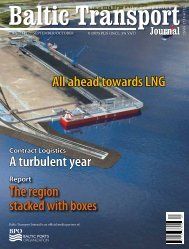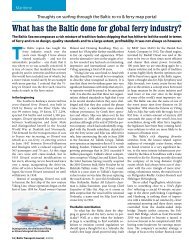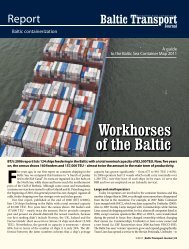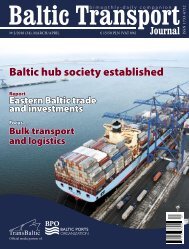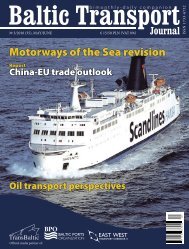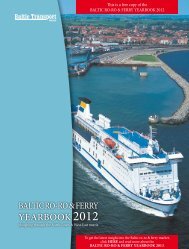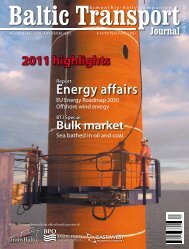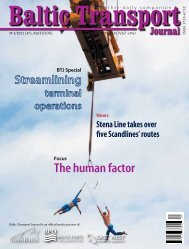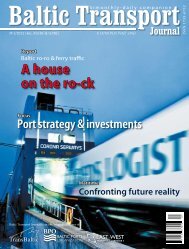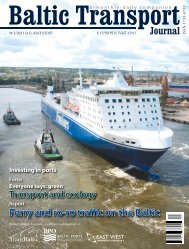Trans<strong>Baltic</strong>Towards an integrated transportsystem in the <strong>Baltic</strong> Sea regionProject part-financedProject part-financedby the European Unionby the European Union (European Regional Development Fund)(European Regional Development Fund)The intergraded transport system in the <strong>Baltic</strong> Sea region – the transit role of LatviaPhoto: Riga’s Transport and Telecommunication InstituteGetting connectedThe transport sector should be perceived as a whole, rather than separate industries and logistics connections.Still the transport network in the EU must not only be united, but also green, as the environmentally friendlyapproach hits the big time. The Trans<strong>Baltic</strong> Stakeholders Debate, held in Riga on 14 th of September, was devotedto the holistic and green development of European transport, with special attention to the transit role of Latvia.Amajor part of the Trans<strong>Baltic</strong> work isdedicated to investigate “The BSR asa transport gateway area”. A subtaskin this investigation is to perform“Forecasts and scenarios for BSR corridor flows”by the modelling of traffic flows. The forecastincludes a projection of transcontinental flowsbetween and through the BSR to/from the FarEast, Central Asia and Russia considering theirpossible freight volumes, collection/distributionregions and physical routes. In this contextTrans<strong>Baltic</strong> arranged a debate in Riga to discussthe importance of Latvia’s transit role.The main goal of the new EU transport policyis aimed at creating a system that supports thedevelopment of the European economy, increasescompetitiveness, provides high qualitymobility services, but which at the same timeuses existing resources more effectively. Also theEuropean Commission’s position on the future oftransport planning is clear – transport is viewedas a basic necessity in the context of other prioritiesor sectors. The transport network shouldserve as the backbone for overall development36 | <strong>Baltic</strong> Transport Journal | 5/<strong>2011</strong>– the better and healthier it is, the overall conditionof the organism is better, too.Three main trends in transport and logisticsin the BSR, as pointed out by Igor Kabashkin,president of Riga’s Transport and TelecommunicationsInstitute, are globalization (the BSR asa gateway for global freight transport), regionalizationand unification (documents, services,procedures and so forth).The mentioned tendencies are facing severalproblems, like the difficulty to alter the mindsetof politicians (the so-called “administrative bottlenecks”along with the clash between political andeconomic agendas), troubling legislation, environmentand safety issues (i.e. to what extent a corridorcan be made green and secure and yet yieldprofits), along with customs and border crossingnuisances. Despite these difficulties, the BSR canbe a future logistics and distribution centre (ora web of such centres), providing value-addedproduction in the custom-free zones and specialeconomic zones. The <strong>Baltic</strong> Sea region has the advantageof a good location, priceless if we take intoconsideration the potential of the Russian market;the BSR also offers skilled labour, which has a goodcommand of English and Russian. Not withoutmeaning are also the <strong>Baltic</strong> hinterland ports, supportingother transport and logistics chains.Co-ompetition (co-operation plus competitionat all levels) will be the key to future successfuldevelopment, according to Kabashkin. Ifco-ompetition is to become a common practice,a vast number of parties much cooperate – centraland local governments, organizations (BPO,IMO, various associations, including ecological organizations),private business and last but not leastsocieties, which are going to be affected by thetransport and logistics infrastructures. The secondfuture key aspect will be optimodality – the wayto optimize each mode of transport consideredseparately and draw the best of the combinationof diverse modes of transport (rail, road, maritime,inland waterways, air) to the benefit of the useras well as the individual consumers. Integrationis the vital condition for the success of the wholeidea; but such integration is needed which doesn’trule out specialization, while saving money andstill providing the BSR with the advantage of
Project part-financedProject part-financedby the European Unionby the European Union (European Regional Development Fund)(European Regional Development Fund)Towards an integrated transportsystem in the <strong>Baltic</strong> Sea regionTrans<strong>Baltic</strong>versatility. As history shows ongoing technologyimprovements (i.e. co-modality, ITS, crossborder innovations) are also required to burstthe integration. In this regard the European Unionhas to take some recommendations intoconsideration. If the EU wants to develop anefficient Trans-European Network of Transport(TEN-T), more attention needs to be placed on<strong>Baltic</strong> transport corridors, as many countriesalong the <strong>Baltic</strong> Sea are a border betweenEU and non-EU nations. The European Unionshould also harmonize the customs legislationbetween the EU and the customs union ofRussia, Belarus, Kazakhstan and Ukraine.And that’s the point of departure for thediscussions on Latvia’s opportunities as an attractiveand important player in the transit axisboth bearing in mind its location as the middleof the three <strong>Baltic</strong> States as well as a transitcountry to and from Russia. Alongside Estoniaand Lithuania, Latvia is mobilising its forces notto be left off the map when the growing Asianeconomies plan their future transport routes.Latvia – as a case study – has the advantageof bordering with both Russia and Belarus andthe institutionalised customs union betweenthese two neighbouring countries and Kazakhstanis perceived as an excellent opportunityto attract freight flows. Development of logisticsand distribution centres could also be onthe agenda with the value-added productionin the custom-free zones. However, the competitionbetween the three <strong>Baltic</strong> States is nota desirable outlook. While rivalling for fundingto develop TEN-T infrastructure links and greentransport technologies, Latvia, Lithuania andEstonia can still cooperate to harmonize planningconcepts and develop their own profilesas transit countries. Thus, co-ompetition at relevantgovernance levels and across the territoriescould be more suitable as a means to findthe right focus in transport policy planning.Also knowledge is essential for co-ompetitionwithin BSR, but it’s widely recognised that adecision-support basis for public authoritiesdoes not exist due to scattered traffic flowdata as well as different methodologies andmodels applied for individual networks. TheTrans<strong>Baltic</strong> Outlook (BTO), recalled as an actionof the ministries in the EU <strong>Baltic</strong> Sea Strategydocument, may partially fill this gap by describingcurrent and predicted goods trafficbetween both BSR countries and regions Asfor now Latvia is preparing its national transportpolicy 2014-2020, but plans are meaningfulwithout actions, a notion which politiciansmust bear in mind to improve their country indetail, and the EU in general.The direction: greenDuring the debate much care was alsotaken regarding the green corridors concept.Photos: Riga’s Transport and Telecommunication InstituteThe concept for imposing greener transportis both a possibility and a threat, meaning thatthis challenge can turn out very well, but alsobring interested parties to ruin. One of the keyfactors is the governments’ enforcement ofgreen thinking onto public and private actorsor green corridors will rather become ghostcorridors with no companies using them, thuslarge investments will be written off. As for nowthe concept was considered by the Latvianstakeholders as not much more than just a slogan,since today all corridors are far from beinggreen. Nonetheless, Trans<strong>Baltic</strong>’s disputantsperceive the green corridors as the only possiblefuture for cost-efficient transport, althoughit will also need a lot of careful investigationsbefore being developed and implemented.So what are the necessary conditions forimplementing green corridors? First of all, policiesmust be changed, both on the nationaland EU level, i.e. fighting off bureaucraticburdens, harmonizing national regulations,as well as creating easy terms for the developmentof green corridors and enabling thegreening of existing ones. If effective greencorridors are to be established, then the economicgaps between neighbourhood countriesmust be filled, because a fragmented“corridor” running across many countries isn’ta corridor at all. Furthermore, border crossingshave to be as simple as possible withless administration for efficient (low emission)transportation. The EU must work their fingersto the bone on optimizing customs unionsand legislations; in this regard joint actionswith Russia, Kazakhstan, Belarus and Ukraineshould be undertaken, as these countriesform a common custom union. Russia needsto be involved in the “green” discussion toinvest in the right corridors, too. Not withoutmeaning is also spreading the good newsthat green corridors are the best solution, notonly from an environmental point of view, butalso in terms of economics. To do so it’s necessaryto develop a common language andunderstanding of the green corridor conceptfor all involved actors (public and private) tounderstand each other and to come out witha widely recognized solution.As the debate was held in Latvia, thecase of importance of green corridors to thiscountry was raised. If the Latvian governmentbecomes more proactive, the strategic consequencesfor Latvia should be positive. If Latvialives for the day it could become the most importanthub for freight transportation throughoutthe <strong>Baltic</strong> States. If green corridors succeed,everybody who has the know-how andexperience in dealing with them will gain anadvantage over lesser committed countries. Przemysław Myszka5/<strong>2011</strong> | <strong>Baltic</strong> Transport Journal | 37



